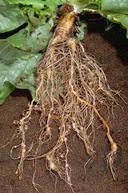
Vegetables & Sustainable
Can crop rotation reduce pest problems?
Overview

Galling of lettuce roots by root knot nematode. (UC IPM)
Crop rotation can be practiced to reduce soil borne pest problems in the garden, particularly nematodes, and root diseases such as verticillium wilt. These problems can increase in severity when susceptible crops or crops in the same family are grown in the same location year after year. It is important to be aware of what pest you are trying to reduce in your crop rotation efforts. For example, plants susceptible to verticillium wilt, such as tomato, should be rotated with plants such as broccoli. There is mounting evidence that broccoli will help to reduce the amount of verticillium in the soil. If reducing nematodes, then it is important that you know which nematode you are trying to reduce. Not all will be helped by crop rotation. Root knot nematode is probably the most well known nematode. Choosing suitable rotations can be confusing because even crops such as corn and onions, that are not seriously damaged by root knot nematodes may still allow build up in the soil. Annual crops that are useful for reducing root knot populations include small grains such as wheat and barely, and resistant tomato and bean varieties. Also, within the rotation it is important to include “fallow” which means to have no plants, not even weeds present in order to prevent the nematodes from feeding and then reproducing. See rotation schedule for a root knot nematode infested garden.
Associated Links
Publications
|
